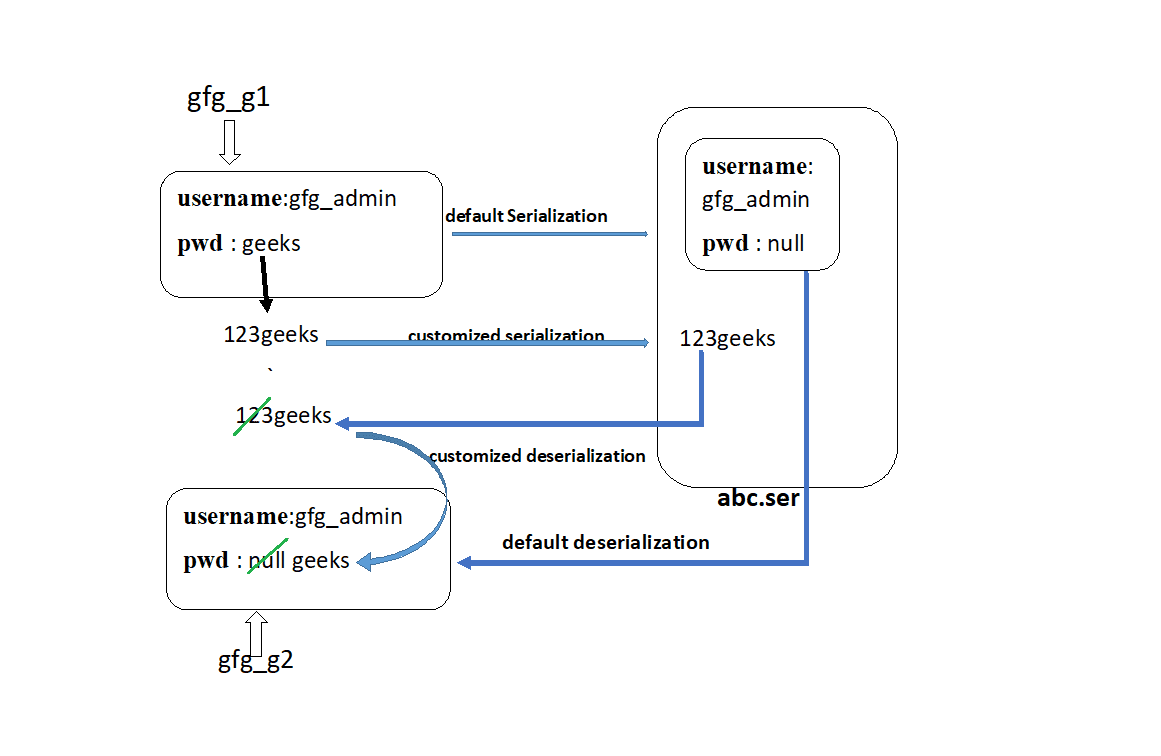系列化 是一种将对象状态转换为字节流的机制。反序列化是使用字节流在内存中重新创建实际Java对象的反向过程。此机制用于持久化对象。
null
为什么需要自定义序列化?
在序列化过程中,如果使用“transient”关键字,可能会丢失数据“Transient”关键字用于我们不想序列化的变量。但有时,需要以与默认序列化不同的方式对它们进行序列化(例如在序列化之前进行加密等),在这种情况下,我们必须使用自定义序列化和反序列化。
以下程序说明了上述数据丢失情况:
// Java program to illustrate loss of information // because of transient keyword. import java.io.*; class GfgAccount implements Serializable { String username = "gfg_admin" ; transient String pwd = "geeks" ; } class CustomizedSerializationDemo { public static void main(String[] args) throws Exception { GfgAccount gfg_g1 = new GfgAccount(); System.out.println( "Username : " + gfg_g1.username + " Password : " + gfg_g1.pwd); FileOutputStream fos = new FileOutputStream( "abc.ser" ); ObjectOutputStream oos = new ObjectOutputStream(fos); // writeObject() method present in GfgAccount class // will be automatically called by jvm oos.writeObject(gfg_g1); FileInputStream fis = new FileInputStream( "abc.ser" ); ObjectInputStream ois = new ObjectInputStream(fis); // readObject() method present GfgAccount class // will be automatically called by jvm GfgAccount gfg_g2 = (GfgAccount)ois.readObject(); System.out.println( "Username : " + gfg_g2.username + " Password : " + gfg_g2.pwd); } } |
输出 :
Username : gfg_admin Password : geeks Username : gfg_admin Password : null
 在上面的图像示例中,在序列化之前,Account对象可以提供正确的用户名和密码,但Account对象的反序列化只提供用户名而不提供密码。这是因为将密码变量声明为瞬态。
在上面的图像示例中,在序列化之前,Account对象可以提供正确的用户名和密码,但Account对象的反序列化只提供用户名而不提供密码。这是因为将密码变量声明为瞬态。
因此,在默认序列化期间,可能会因为transient关键字而丢失信息。为了弥补这一损失,我们将不得不使用 自定义序列化。
可以使用以下两种方法实现自定义序列化:
- 私有void writeObject(ObjectOutputStream oos)引发异常
- private void readObject(ObjectInputStream ois)抛出异常:在反序列化时,jvm(也称为回调方法)将自动执行此方法。因此,要在反序列化期间执行任何活动,必须仅在此方法中定义它。
:此方法将在序列化时由jvm(也称为回调方法)自动执行。因此,要在序列化期间执行任何活动,必须仅在此方法中定义它。
注: 在执行对象序列化时,我们必须在该类中定义上述两个方法。
// Java program to illustrate customized serialization import java.io.*; class GfgAccount implements Serializable { String username = "gfg_admin" ; transient String pwd = "geeks" ; // Performing customized serialization using the below two methods: // this method is executed by jvm when writeObject() on // Account object reference in main method is // executed by jvm. private void writeObject(ObjectOutputStream oos) throws Exception { // to perform default serialization of Account object. oos.defaultWriteObject(); // epwd (encrypted password) String epwd = "123" + pwd; // writing encrypted password to the file oos.writeObject(epwd); } // this method is executed by jvm when readObject() on // Account object reference in main method is executed by jvm. private void readObject(ObjectInputStream ois) throws Exception { // performing default deserialization of Account object ois.defaultReadObject(); // deserializing the encrypted password from the file String epwd = (String)ois.readObject(); // decrypting it and saving it to the original password // string starting from 3rd index till the last index pwd = epwd.substring( 3 ); } } class CustomizedSerializationDemo { public static void main(String[] args) throws Exception { GfgAccount gfg_g1 = new GfgAccount(); System.out.println( "Username :" + gfg_g1.username + " Password :" + gfg_g1.pwd); FileOutputStream fos = new FileOutputStream( "abc.ser" ); ObjectOutputStream oos = new ObjectOutputStream(fos); // writeObject() method on Account class will // be automatically called by jvm oos.writeObject(gfg_g1); FileInputStream fis = new FileInputStream( "abc.ser" ); ObjectInputStream ois = new ObjectInputStream(fis); GfgAccount gfg_g2 = (GfgAccount)ois.readObject(); System.out.println( "Username :" + gfg_g2.username + " Password :" + gfg_g2.pwd); } } |
输出 :
Username :gfg_admin Password :geeks Username :gfg_admin Password :geeks

© 版权声明
文章版权归作者所有,未经允许请勿转载。
THE END


![关于”PostgreSQL错误:关系[表]不存在“问题的原因和解决方案-yiteyi-C++库](https://www.yiteyi.com/wp-content/themes/zibll/img/thumbnail.svg)






